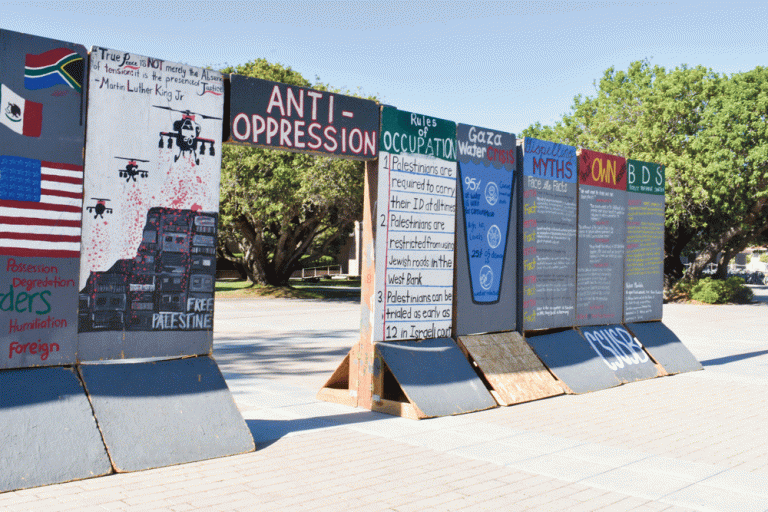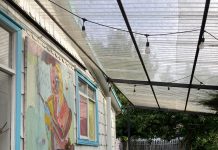
Bailee Abell
Staff Writer
Students for Justice in Palestine erected a wall in the Arbor this week to advocate for the divestment from companies that allegedly profit from human rights violations in Palestine and Israel. The wall was met with strong reactions from Students Supporting Israel, among other students who are opposed to divestment.
Located at the edge of the Arbor near the former library entrance, the wall features a collage of quotes, symbols, phrases, and graphics in support of divestment. Students must either walk through the makeshift doorway of the wall or walk around it in order to enter the Arbor walkway area.
SJP member Anumita Kaur stated that the wall was placed in the Arbor to symbolize “the very real apartheid wall that snakes amongst and between Palestine/Israel,” as well as to educate the University of California, Santa Barbara campus about the ways in which, “Palestinians are currently living under apartheid and occupation.” Each of of the wall’s panels contains information, such as graphics and statistics, about the experiences of Palestinians and what SJP and other pro-divestment advocates want to change.
According to Kaur — who is also the student sponsor for A Resolution to Divest from Companies that Profit from Human Rights Violations in Palestine/Israel — the wall was first assembled years ago by a group of activists in solidarity with Palestine. Since its initial installation, the wall has been shared among several college campuses in California. It is updated yearly with new information. “The Wall, in its conception and its erection almost every year on this campus, is a labor of love,” Kaur said.
But although Kaur and other SJP members in favor of divestment advocate for the presence of the wall, many students on campus do not view it as a “labor of love” but instead believe that it “drives peace away” between pro- and anti-divestment groups, according to Students Supporting Israel president Nate Erez.
“As President of SSI, I want to emphasize how important healthy criticism of Israeli policy is,” he wrote to The Bottom Line. “But there is nothing healthy about this grossly offensive wall SJP erected this week.”
Erez stated that the wall “grossly misrepresents” Zionism and is “littered with outright lies,” pointing to an alleged misquote of David Ben-Gurion, the first prime minister of Israel, as well as the wall’s “denial that Israel even exists as a sovereign nation.” Erez also stated that many members of the Jewish community feel “disturbed” while walking through campus, as they are “completely unable to avoid such an aggressive attack on the Jewish, Israeli, and Zionist identity.”
“I encourage dialogue, but this display depicts one side as an all-powerful, evil entity,” Erez wrote. “This only drives peace for both Israelis and Palestinians further away. This is a very difficult time to be a Jewish and Zionist UCSB student … a path to peace is only possible when both sides recognize each other’s right to self determine, and we no longer engage in characterizations that paint the other side as evil entities who seek death and destruction.”
While Erez believes the wall hinders the prospect of peace between Israel and Palestine by “denying the right of Jews to self-determine,” Kaur takes a different approach to the issue. She pointed to the dismantling of slavery in the U.S. and the dismantling of the apartheid in South Africa as examples of “struggles for justice and equality” that occurred with conflict and divisive opinions.
“Sometime truth necessitates discomfort,” she stated, referring to the contents displayed on the wall. “Sometimes education requires you to step out of your comfort zone … if we are afraid to challenge the status quo and agitate our complacency, we will never achieve any sort of justice, peace, or equality in this world.”
The wall coincides with the recent SJP-sponsored resolution, which calls for divestment from said companies. The resolution reads that UCSB should “actively dismantle systems of racism, patriarchy, homophobia, transphobia, imperialism, colonization, and environmental degradation,” rather than contributing to such systems. It also states that certain companies in which UCSB currently invests “have promoted and been complicit in human rights violations committed by the Israeli government.”
Though resolutions to divest from these alleged human rights violations have been sponsored and presented at A.S. Senate meetings in 2013, 2014, 2015, and now 2017, UCSB has yet to pass such a resolution, making the university the only undergraduate UC to do so.
The wall will remain in the Arbor until this Friday. Senate did not discuss the resolution, as previously suggested, at their Wednesday night meeting.
UPDATE
May 4, 12:11 p.m.: This article has been updated for clarity.








We should actively divest from those who support Palestine a terrorist state who only survives because of other terrorist states
Your ignorance is baffling.
Good work, Bailee–this is evenhanded, reasoned reporting on a thorny issue with a variety of strong emotions/opinions around it. I’ve been really pleased to read the Bottom Line lately; strong standards of reporting and journalistic integrity here. You’re giving me hope in media.
Comments are closed.